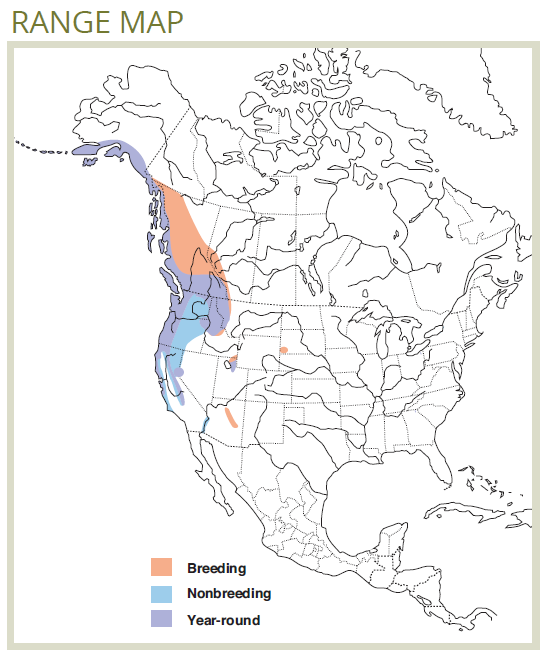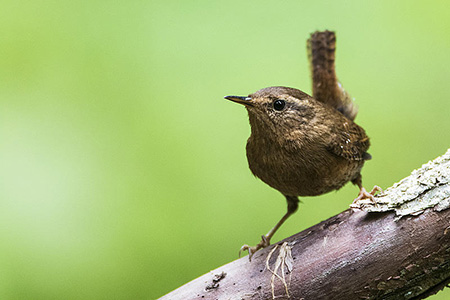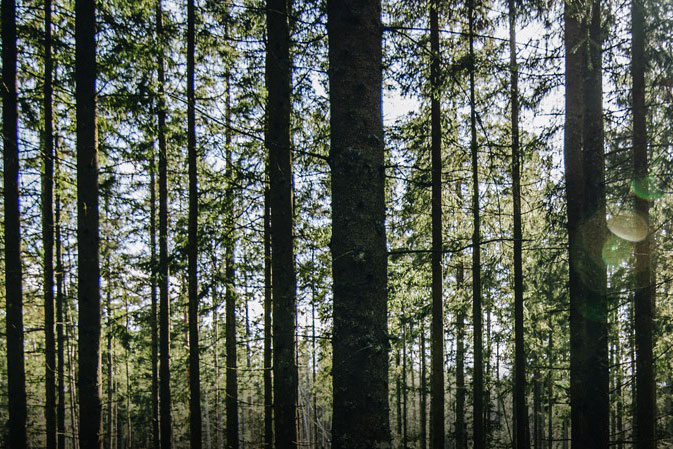Until 2010, the Pacific Wren was considered a sub-species of the Winter Wren. It is small and well-camouflaged but is easily detected by its complex and vibrant song.
Pacific Wren
(Troglodytes pacificus)
Habitat Ecology
- The Pacific Wren is a year-round resident in parts of its range, including southern interior BC. During the breeding season, its range extends to include central and northern interior BC and the Alberta foothills.1
- This species is strongly associated with old coniferous forests that contain old forest features including snags, upturned tree root masses, downed trees, and large-diameter trees.1
- The most suitable habitats for Pacific Wren include old western hemlock forests2,3 and/or closed conifer forest >200 years old (e.g., Douglas fir, western red cedar, etc.).4
- In BC, the Pacific Wren is often found within 5 m of streams <10 m wide, where they nest on stream banks under soil overhangs and upturned root masses.1,5,6

Response to Forest Management
- Clear-cutting and partial harvest reduce habitat suitability for the Pacific Wren3 for up to 40 years,7 however harvesting that retains high snag densities, slash piles, and upturned root masses may improve postharvest habitat quality.1,8
- Reduced densities of Pacific Wren near forest edges,9 forest stands <20 ha.1 and in narrow riparian buffers (avg. 13 m)10 suggest that this species is sensitive to fragmentation of late-seral habitats.
Stand-level Recommendations
- Recommended retention patch anchors include large-diameter downed logs, large-diameter trees, and fallen trees with large rootwads. Slash piles and shrub cover protection (i.e., maintaining >60% shrub cover) are also considered likely to improve habitat quality within harvested stands.1,11
- The creation of small canopy gaps using selection cutting may be an appropriate strategy, but would require the targeted retention of important habitat features including snags, downed woody debris, large-diameter trees, and upturned root masses.6
- Cutblocks <10 ha that contain 10% dispersed retention may provide sub-optimal breeding habitat for Pacific Wrens, provided they are near mature or old forest.12
- Wide riparian buffers (e.g., >40 m), particularly along streams <10 m wide and including snags and downed trees, may represent suitable breeding habitat.6,10,11
Landscape-level Recommendations
- On landscapes managed within the area’s NRV, unfragmented forest stands larger than 30 ha and >80 years old (preferably >200 years old if available) are considered the most valuable habitats for conserving the Pacific Wren.1
Knowledge Gaps
- The majority of research on the Pacific Wren has been concentrated within coastal forests. Further research is needed to assess Pacific Wren responses to forest management in interior BC and determine whether similar habitat features are of equal importance to breeding pairs in these areas.
References
- Toews, D. P. L. & Irwin, D. E. 2012. Pacific Wren (Troglodytes pacificus), version 2.0. in The Birds of North America (Rodewald, P. G., ed.) Cornell Lab of Ornithology, Ithaca, New York, USA. Available online: https://birdsna.org/Species-Account/bna/species/pacwre1
- Mclachlin, R. A. 1983. Dispersion of the western winter wren (Troglodytes troglodytes pacificus [Baird]) in coastal western hemlock forest at the University of British Columbia Research Forest in south-western British Columbia. Ph.D. Thesis. Dept. of Forestry, University of British Columbia, Vancouver, BC. 275 pp. Available online: https://open.library.ubc.ca/cIRcle/collections/ubctheses/831/items/1.009…
- Hutto, R. L. & Young, J. S. 1999. Habitat relationships of landbirds in the Northern Region, USDA Forest Service. Gen. Tech. Rep. RMRS-GTR-32. U.S. Department of Agriculture, Forest Service, Rocky Mountain Research Station, Ogden, UT. 72 pp. Available online: https://www.fs.fed.us/rm/pubs/rmrs_gtr032.pdf
- Adamus, P. R., Baker, J. P., White, D., Santelmann, M. & Haggerty, P. 2000. Terrestrial Vertebrate Species of the Willamette River Basin: Species–Habitat Relationships Matrix. Internal Report. U.S. Environmental Protection Agency, Corvallis, OR.
- Anthony, R. G., Green, G. A., Forsman, E. D. & Nelson, S. K. 1996. Avian abundance in riparian zones of three forest types in the Cascade Mountains, Oregon. Wilson Bulletin 108: 280–291. Available online: http://www.science.fau.edu/biology/gawliklab/papers/AnthonyRG-etal1996.pdf
- Waterhouse, F. L., Harestad, A. S. & Ott, P. K. 2002. Use of small streams and forest gaps for breeding habitats by winter wrens in coastal British Columbia. Northwest Science 76: 335–346. Available online: https://research.wsulibs.wsu.edu/xmlui/bitstream/handle/2376/924/v76 p335 Waterhouse et al.PDF?sequence=1&isAllowed=y
- McGarigal, K. & McComb, W. C. 1995. Relationships between landscape structure and breeding birds in the Oregon Coast Range. Ecological Monographs 65: 235–260. Available online: http://www.jstor.org/stable/2937059
- Zarnowitz, J. E. & Manuwal, D. A. 1985. The effects of forest management on cavity-nesting birds in northwestern Washington. The Journal of Wildlife Management 49: 255–263. Available online: http://www.jstor.org/stable/3801881
- Catt, D. J. 1991. Bird communities and forest succession in the subalpine zone of Kootenay National Park, British Columbia. M.Sc. Thesis. Department of Biological Sciences, Simon Fraser University, Vancouver, BC. 99 pp. Available online: http://summit.sfu.ca/item/4788
- Pearson, S. F., Giovanini, J., Jones, J. E. & Kroll, A. J. 2015. Breeding bird community continues to colonize riparian buffers ten years after harvest. PLoS ONE 10: e0143241. Available online: https://doi.org/10.1371/journal.pone.0143241
- Hagar, J. C. 1999. Influence of riparian buffer width on bird assemblages in western Oregon. The Journal of Wildlife Management 63: 484–496. Available online: http://www.jstor.org/stable/3802633
- Waterhouse, F. L. & Harestad, A. S. 2002. Habitat use of a dispersed retention area by breeding Winter Wrens. Technical Report TR-020. Research Section, Vancouver Forest Region, BC Ministry of Forests, Nanaimo, BC. 16 pp. Available online: https://www.for.gov.bc.ca/rco/research/wildlifereports/tr020.pdf








